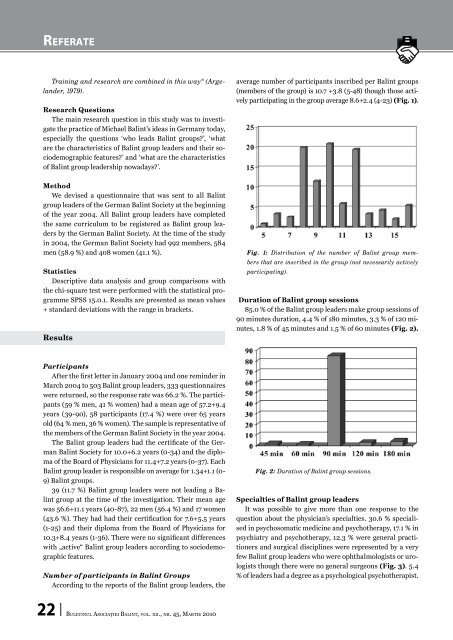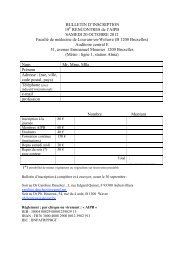Marie 2010
martie 2010 - Psychodrame Balint
martie 2010 - Psychodrame Balint
Create successful ePaper yourself
Turn your PDF publications into a flip-book with our unique Google optimized e-Paper software.
ReferateTraining and research are combined in this way“ (Argelander,1979).Research QuestionsThe main research question in this study was to investigatethe practice of Michael Balint’s ideas in Germany today,especially the questions ‘who leads Balint groups?’, ‘whatare the characteristics of Balint group leaders and their sociodemographicfeatures?’ and ‘what are the characteristicsof Balint group leadership nowadays?’.MethodWe devised a questionnaire that was sent to all Balintgroup leaders of the German Balint Society at the beginningof the year 2004. All Balint group leaders have completedthe same curriculum to be registered as Balint group leadersby the German Balint Society. At the time of the studyin 2004, the German Balint Society had 992 members, 584men (58.9 %) and 408 women (41.1 %).StatisticsDescriptive data analysis and group comparisons withthe chi-square test were performed with the statistical programmeSPSS 15.0.1. Results are presented as mean values+ standard deviations with the range in brackets.Resultsaverage number of participants inscribed per Balint groups(members of the group) is 10.7 +3.8 (5-48) though those activelyparticipating in the group average 8.6+2.4 (4-23) (Fig. 1).Fig. 1: Distribution of the number of Balint group membersthat are inscribed in the group (not necessarily activelyparticipating).Duration of Balint group sessions85.0 % of the Balint group leaders make group sessions of90 minutes duration, 4.4 % of 180 minutes, 3.3 % of 120 minutes,1.8 % of 45 minutes and 1.5 % of 60 minutes (Fig. 2).ParticipantsAfter the first letter in January 2004 and one reminder inMarch 2004 to 503 Balint group leaders, 333 questionnaireswere returned, so the response rate was 66.2 %. The participants(59 % men, 41 % women) had a mean age of 57.2+9.4years (39-90), 58 participants (17.4 %) were over 65 yearsold (64 % men, 36 % women). The sample is representative ofthe members of the German Balint Society in the year 2004.The Balint group leaders had the certificate of the GermanBalint Society for 10.0+6.2 years (0-34) and the diplomaof the Board of Physicians for 11.4+7.2 years (0-37). EachBalint group leader is responsible on average for 1.34+1.1 (0-9) Balint groups.39 (11.7 %) Balint group leaders were not leading a Balintgroup at the time of the investigation. Their mean agewas 56.6+11.1 years (40-87), 22 men (56.4 %) and 17 women(43.6 %). They had had their certification for 7.6+5.5 years(1-25) and their diploma from the Board of Physicians for10.3+8.4 years (1-36). There were no significant differenceswith „active“ Balint group leaders according to sociodemographicfeatures.Number of participants in Balint GroupsAccording to the reports of the Balint group leaders, theFig. 2: Duration of Balint group sessions.Specialties of Balint group leadersIt was possible to give more than one response to thequestion about the physician’s specialties. 30.6 % specialisedin psychosomatic medicine and psychotherapy, 17.1 % inpsychiatry and psychotherapy, 12.3 % were general practitionersand surgical disciplines were represented by a veryfew Balint group leaders who were ophthalmologists or urologiststhough there were no general surgeons (Fig. 3). 5.4% of leaders had a degree as a psychological psychotherapist.22Buletinul Asociaţiei Balint, vol. xii., nr. 45, Martie <strong>2010</strong>



